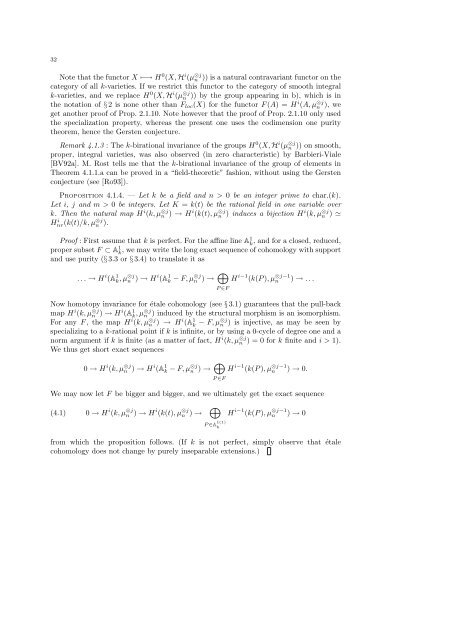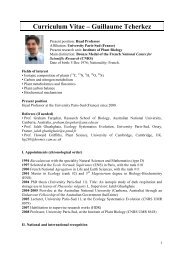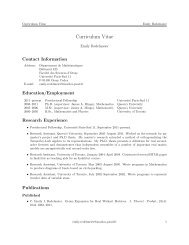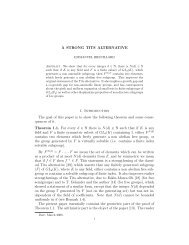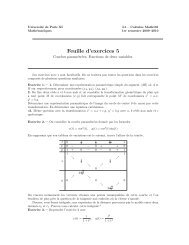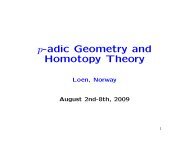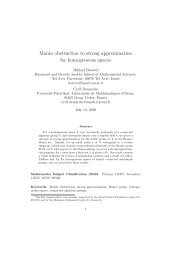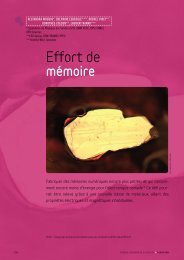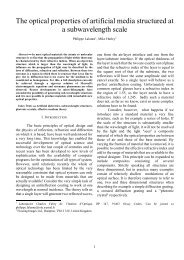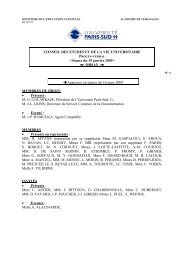Birational invariants, purity and the Gersten conjecture Lectures at ...
Birational invariants, purity and the Gersten conjecture Lectures at ...
Birational invariants, purity and the Gersten conjecture Lectures at ...
You also want an ePaper? Increase the reach of your titles
YUMPU automatically turns print PDFs into web optimized ePapers that Google loves.
32<br />
Note th<strong>at</strong> <strong>the</strong> functor X ↦−→ H 0 (X, H i (µ ⊗j<br />
n )) is a n<strong>at</strong>ural contravariant functor on <strong>the</strong><br />
c<strong>at</strong>egory of all k-varieties. If we restrict this functor to <strong>the</strong> c<strong>at</strong>egory of smooth integral<br />
)) by <strong>the</strong> group appearing in b), which is in<br />
<strong>the</strong> not<strong>at</strong>ion of § 2 is none o<strong>the</strong>r than F loc (X) for <strong>the</strong> functor F (A) = H i (A, µ ⊗j<br />
n ), we<br />
k-varieties, <strong>and</strong> we replace H 0 (X, H i (µ ⊗j<br />
n<br />
get ano<strong>the</strong>r proof of Prop. 2.1.10. Note however th<strong>at</strong> <strong>the</strong> proof of Prop. 2.1.10 only used<br />
<strong>the</strong> specializ<strong>at</strong>ion property, whereas <strong>the</strong> present one uses <strong>the</strong> codimension one <strong>purity</strong><br />
<strong>the</strong>orem, hence <strong>the</strong> <strong>Gersten</strong> <strong>conjecture</strong>.<br />
Remark 4.1.3 : The k-bir<strong>at</strong>ional invariance of <strong>the</strong> groups H 0 (X, H i (µ ⊗j<br />
n )) on smooth,<br />
proper, integral varieties, was also observed (in zero characteristic) by Barbieri-Viale<br />
[BV92a]. M. Rost tells me th<strong>at</strong> <strong>the</strong> k-bir<strong>at</strong>ional invariance of <strong>the</strong> group of elements in<br />
Theorem 4.1.1.a can be proved in a “field-<strong>the</strong>oretic” fashion, without using <strong>the</strong> <strong>Gersten</strong><br />
<strong>conjecture</strong> (see [Ro93]).<br />
PROPOSITION 4.1.4. — Let k be a field <strong>and</strong> n > 0 be an integer prime to char.(k).<br />
Let i, j <strong>and</strong> m > 0 be integers. Let K = k(t) be <strong>the</strong> r<strong>at</strong>ional field in one variable over<br />
k. Then <strong>the</strong> n<strong>at</strong>ural map H i (k, µ ⊗j<br />
n ) → H i (k(t), µ ⊗j<br />
n ) induces a bijection H i (k, µ ⊗j<br />
n ) ≃<br />
Hnr(k(t)/k, i µ ⊗j<br />
n ).<br />
Proof : First assume th<strong>at</strong> k is perfect. For <strong>the</strong> affine line A 1 k<br />
, <strong>and</strong> for a closed, reduced,<br />
proper subset F ⊂ A 1 k<br />
, we may write <strong>the</strong> long exact sequence of cohomology with support<br />
<strong>and</strong> use <strong>purity</strong> (§ 3.3 or § 3.4) to transl<strong>at</strong>e it as<br />
. . . → H i (A 1 k, µ ⊗j<br />
n<br />
) → H i (A 1 k − F, µ ⊗j<br />
n ) → ⊕ H i−1 (k(P ), µ n ⊗j−1 ) → . . .<br />
P ∈F<br />
Now homotopy invariance for étale cohomology (see § 3.1) guarantees th<strong>at</strong> <strong>the</strong> pull-back<br />
map H i (k, µ ⊗j<br />
n ) → H i (A 1 k , µ⊗j n ) induced by <strong>the</strong> structural morphism is an isomorphism.<br />
For any F , <strong>the</strong> map H i (k, µ ⊗j<br />
n ) → H i (A 1 k<br />
− F, µ⊗j n ) is injective, as may be seen by<br />
specializing to a k-r<strong>at</strong>ional point if k is infinite, or by using a 0-cycle of degree one <strong>and</strong> a<br />
norm argument if k is finite (as a m<strong>at</strong>ter of fact, H i (k, µ ⊗j<br />
n ) = 0 for k finite <strong>and</strong> i > 1).<br />
We thus get short exact sequences<br />
0 → H i (k, µ ⊗j<br />
n<br />
) → H i (A 1 k − F, µ ⊗j<br />
n ) → ⊕ H i−1 (k(P ), µ n ⊗j−1 ) → 0.<br />
P ∈F<br />
We may now let F be bigger <strong>and</strong> bigger, <strong>and</strong> we ultim<strong>at</strong>ely get <strong>the</strong> exact sequence<br />
(4.1) 0 → H i (k, µ ⊗j<br />
n ) → H i (k(t), µ ⊗j<br />
n ) → ⊕<br />
P ∈A 1(1)<br />
k<br />
H i−1 (k(P ), µ ⊗j−1<br />
n ) → 0<br />
from which <strong>the</strong> proposition follows. (If k is not perfect, simply observe th<strong>at</strong> étale<br />
cohomology does not change by purely inseparable extensions.)


